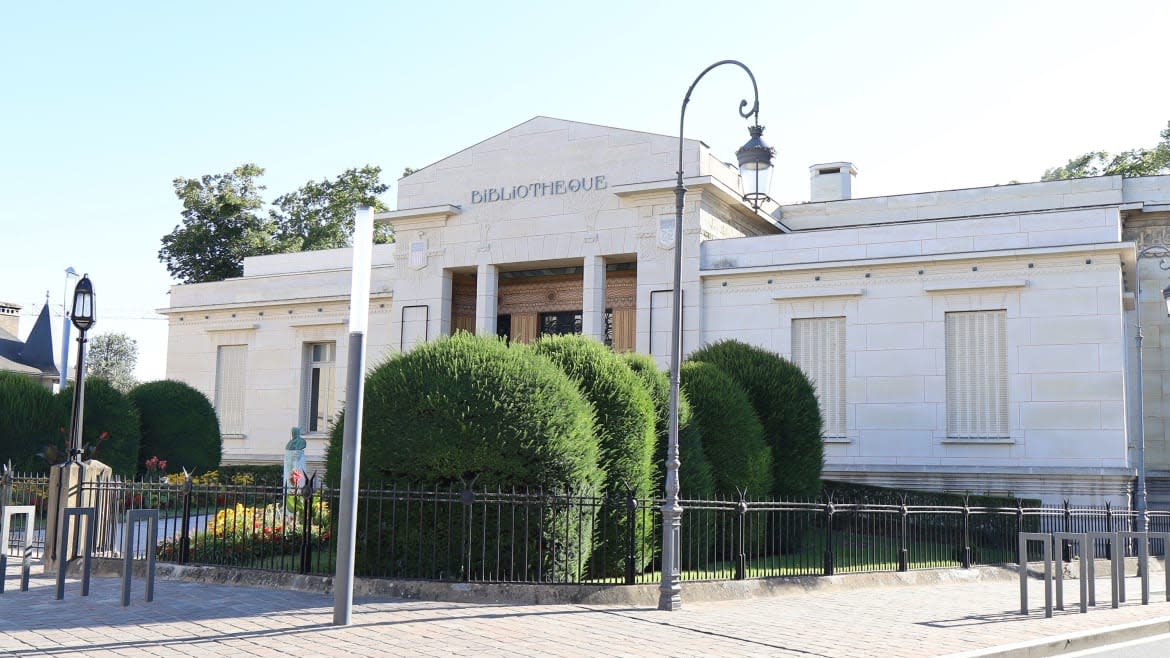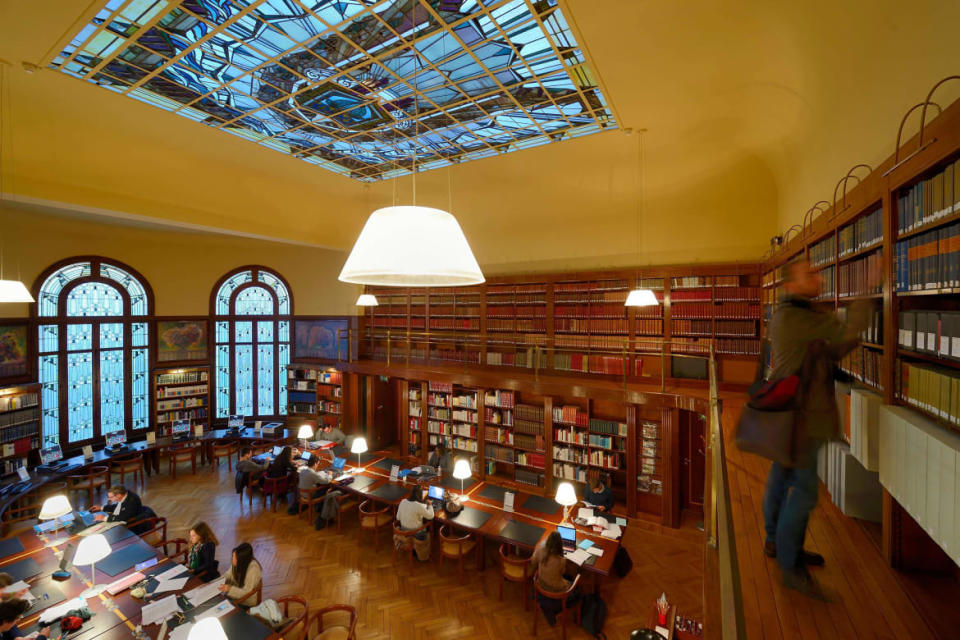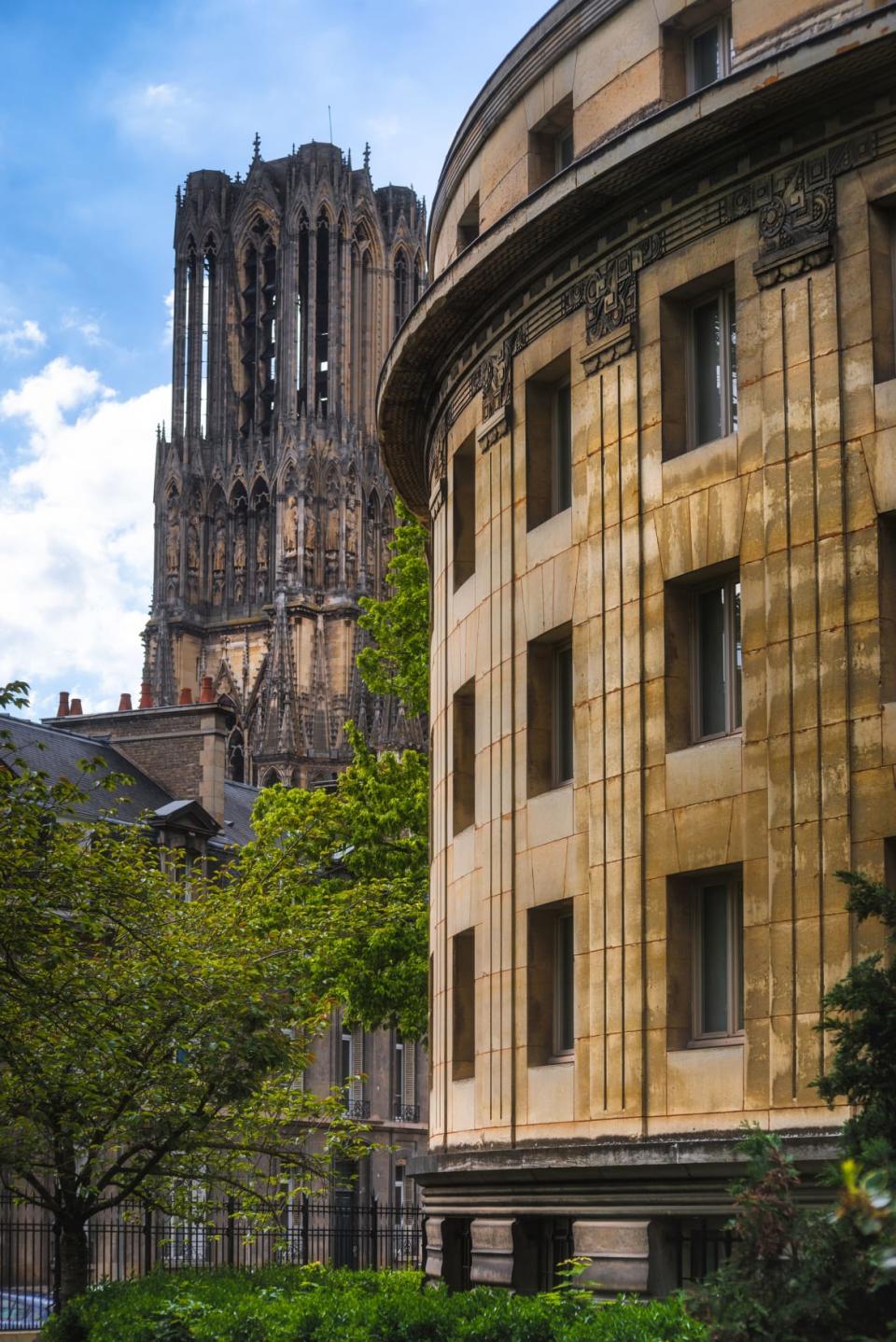A Beautiful Art Deco Library Is Hiding in the Shadow of a World-Famous Cathedral

- Oops!Something went wrong.Please try again later.
The Carnegie Library of Reims is an undeniable, art deco dream. But it’s also incredibly easy to miss. Located right across the square from the Cathédrale Notre-Dame de Reims, the building is literally dwarfed by its ostentatious neighbor, a UNESCO World Heritage site that traditionally served as the location for the coronation of French kings. During World War I, the church was also notable as a safe haven, with a red cross flag marking the structure off-limits as a military target. Perhaps it’s fitting, or at least low-key poetic, that post-World War I, the library next door was built to offer a different kind of refuge, making it an unexpected entry in The Daily Beast’s “The World’s Most Beautiful Libraries”.
Reims is a city of about 180,000 people, with a bucolic reputation enhanced by the fact it also serves as the unofficial capital of the Champagne region—meaning a good number of visitors are probably experiencing the region’s charms while tipsy. But after World War I the city looked significantly different. Thanks to German occupation, Reims had experienced the horrors of war, including loss of life, disruption of business, and significant structural damage to over 60 percent of its buildings.
Enter Andrew Carnegie.
It might seem strange that a Scottish-American philanthropist concerned himself with post-war efforts, or that his donations would take the form of such a specific form of infrastructure. However, like nearly every building, the existing library had been seriously damaged. And Carnegie was partial to the kind of giving that would allow people to help themselves. Also, the dude just loved libraries, building over 1,689 of them across the United States, and speaking about them with the kind of elevated reverence one usually reserves for romantic partners.
“There is not such a cradle of democracy upon the earth as the free public library,” he once noted. “This republic of letters, where neither rank, office, nor wealth receives the slightest consideration."
And so, along with two other frontline cities: Leuven, Belgium, and Belgrade, Serbia, Reims was given $200,000 to rebuild through the Carnegie Endowment for International Peace.

The Carnegie Library of Reims in Art Nouveau style, the three bay windows and the glass roof of the reading room were designed by the master glassmaker Jacques Gruber of Nancy.
That lump sum would be worth roughly $3.93 million today. But despite having a large portion of its collection destroyed in the bombing of city hall, the institution made the money go a long way. To create its new permanent home, it reached out to semi-local architect Max Sainsaulieu, a graduate of the École Nationale Supérieure des Beaux-Arts in Paris. Having completed the Basilica of St. Clotilde in Reims, he was well-acquainted with ornate, neo-gothic architecture. Initially, he searched for inspiration from libraries in Switzerland and Belgium. However, he ultimately settled on Art Deco as the style, which was perceived to be more modern.
Opened to the public on June 10, 1928—with the French president in attendance—the 44,000 square feet building was smaller than most of the region’s grand libraries. (A hiccup of a building, compared to the National Library in Paris’ 624,307 square feet of floor space.) However, ornamentation was heavily prioritized, making it still one of the most beautiful places in the world to stop for a book. And thanks to a restoration in 2005 by architects Jacques Bléhaut and Jean-Loup Roubert, the experience of walking into the library remains largely unchanged—save for some much-needed tweaks to allow for increased accessibility and air conditioning.
With its exterior columns and lacey ironwork by Schwartz-Haumont (the company that took a gold medal at the 1925 Arts Déco Exhibition in Paris), the Carnegie Library has all the hallmarks of a modern temple. (It also features a Bibliothèque sign stylized enough to make Wes Anderson weep—proving just how well the aesthetic has aged.) Entering requires walking up a short flight of stairs in order to “ascend to knowledge,” and walking under an engraved motto from sculptor Edouard Sedley that reads “Educunt folia fructum,” or “flowers lead to fruit.” (One imagines Andrew Carnegie’s joy at all this high-brow, library-based symbolism.)

Public Carnegie Library garden and front tower of Reims cathedral on square Place Carnegie, summer, Reims.
Likewise, the lobby hits with a larger-than-life gravitas that feels equally split between art-gallery chic and detective-agency foreboding. Behind the public area is a semi-circular storage unit containing 400,000 books stretched across five levels. But here in the public area, there’s room for additional flourishes, including an opulent, stained glass skylight by Jacques Simon, and green marble and onyx fountain which—symbolism alert—represents nothing less than “the source of all science and knowledge.”
The library prioritizes function without sacrificing form. After all, what’s the use of having 100,000 books printed between the 16th and 18th centuries (including 8,000 that are considered particularly rare), if you can’t actually get to them? Dark wood shelving, a card catalog that runs nine rows high, and chevron-patterned floors line the reading rooms and ‘salle de lecture’—all design elements that we’ve come to consider hallmarks of places of higher learning. But even the more “modest” reading rooms are flanked by rounded, stained glass windows, bathing would-be knowledge seekers in natural light. (Feel free to draw your own symbolism here.)
In 1983, the Carnegie Library of Reims was declared a historical monument. It continued to serve as Reims’ main library until 2003. Now it’s just one of seven lending instructions scattered throughout the city. (Although arguably it’s still the most aesthetically pleasing.) Some of Carnegie’s statements continue to sound overly poetic. (“A library outranks any other one thing a community can do to benefit its people,” he notes.” It is a never-failing spring in the desert.”) However, Reims’ rebuilding success story has proven his idealism correct. No matter who you are, egalitarianism and knowledge is a beautiful combination.
Get the Daily Beast's biggest scoops and scandals delivered right to your inbox. Sign up now.
Stay informed and gain unlimited access to the Daily Beast's unmatched reporting. Subscribe now.

